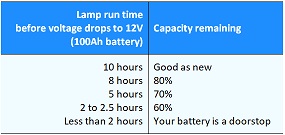Testing your battery
If you have a single battery, you probably have a fair idea already of the health of your battery. If you have more than one battery connected in parallel, there's every chance that one of them is less healthy than the other.
Testing a lead acid battery
If you have multiple batteries in parallel, disconnect them and test each one individually. It is also important to not rely on the first test only (unless your battery scores top marks), but to repeat the test up to three times.
- Charge your battery at 14.4V until the charging amps as per your battery charger or clamp meter drop down to one or two amps and don't drop any further. This could take a couple of days.
- Let the battery sit overnight with nothing connected (either in or out).
- The next morning, for a 100Ah battery, connect a 60W light bulb (or calculate what size light bulb you need for your battery capacity from the example below).
![]()
For example:
If you have let the battery sit overnight and the voltage has already dropped to below 12.8V the next morning with nothing connected to it, this is a fair indication that the battery is on its way out, and this will show up when you start doing the testing.
If the battery has a surface charge because it's sulphated, that first-thing-in-the morning voltage before you put the load on could be 13.8 to 14 volts, but as soon as you put the load (ie the light bulb) on, this voltage will drop rapidly to 12.8V or less. This is just the surface voltage being burnt off. This is why you should repeat this voltage test.
Match your result to the following health check table:

Testing an unsealed lithium battery
- Charge until each cell is above 3.6V and all the cells across the battery are even (within 150mV).
- Let the battery sit overnight.
- If the cells are above 3.45V the next morning, you can proceed to the next part of the test.
- If the cells are not above 3.45V the next morning, charge again until they're all up to 3.6V. Keep repeating until all the cells will hold more than 3.45V overnight.
- When all the cells are holding 3.45V overnight, connect a 50A load per 100ah capacity. You can connect to one cell or to the whole battery.
At the end of 2 hours, while the 50A load is still connected, all the cell voltages should still be above 2.8V. If you get this result, the battery is as good as when it left the factory.
If you don't get this result, recharge the battery or cell and try again. By trying again, you are clearing memory charge and discharge voltages.
This is how we test a battery when a customer comes in for a service. So far, every one of our customers who have done this have a minimum of 100% of their original capacity.
Testing a sealed lithium battery
If you have a sealed lithium battery - ie all in one block where you can't get to the cell terminals - there is no way to know what the individual cell voltages are, so any testing is guesswork. You cannot definitively say that the whole battery has died or if one or more cells have died. And really, if you can't replace a cell, there's probably no point knowing.

Your battery and inverter are the power houses of your RV. The best in the world cannot overcome sub-standard cabling and poor connections.
Connecting cables with crimps and lugs
Using the right lugs and connectors to join cable and using them in the right way is just as important as the actual cable you use to connect batteries, inverters and solar.
We see it so often: the battery isn't giving enough power, the fridge isn't keeping food cool, the solar panels aren't bringing in power. Seldom to RV owners look at the cabling as being a possible cause of the problem.
In 2011 we decided the only way to figure out the best configuration and the safe cell voltage for a lithium battery is to test and destroy until we found out for ourselves what works and what doesn't.
